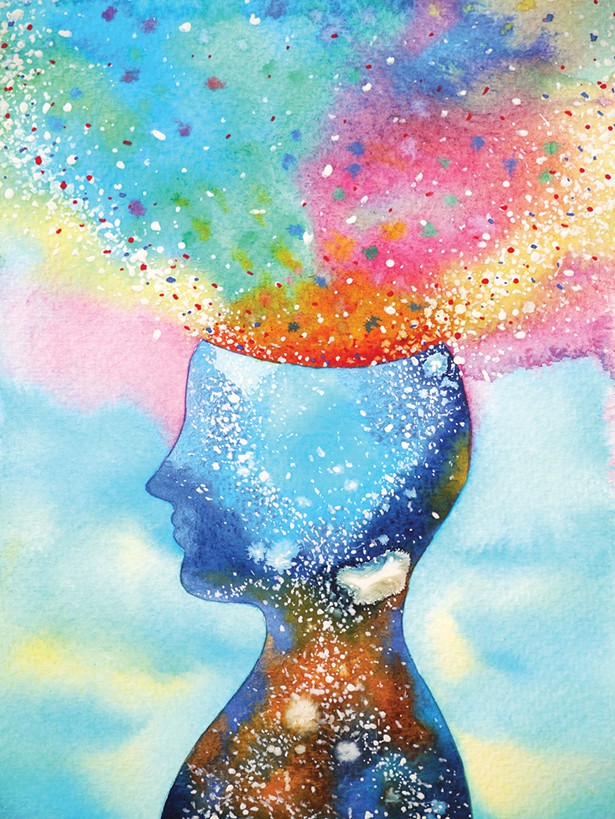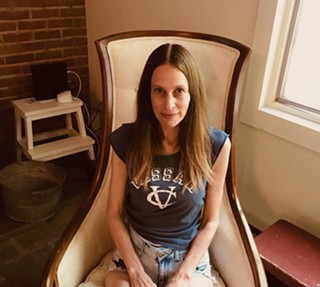Well, hello there, 2020. Hello and hallelujah to the promise of a new year, a new decade, a blank slate where everything is possible. Or is it? Round about now, many of us are diving into freshly minted goals and resolutions. Yet after a promising start, old patterns dog our progress and we return to our pre-January ways of being. We feel stuck. If this sounds familiar, take heart. I talked to experts from three different traditions—neurofeedback, mindfulness, and cognitive behavioral therapy—to find out how we can get unstuck once and for all, and effect the positive changes we want to see in our lives. Here is their wisdom.
Retraining Your Brain with Neurofeedback
Amy McTear has seen all sorts of people set all sorts of goals—it's part of her work as a life coach, counselor, and neurofeedback trainer in New Paltz. After seeing many people struggle with their goals unsuccessfully, McTear grew curious about why it is so hard for many of us to bring about the shifts we deeply desire on the conscious level. And what she found were roadblocks on the unconscious level. "A huge reason why people don't change is because most of our programming happens before the age of six years old," she says. "It creates a template in the brain, so a lot of our beliefs about who we are, our self-image, are created before age six. That becomes the default in your life, unless you intervene."
McTear started looking for ways to address these roadblocks on a neurological or subconscious level. At the same time, someone close to her was suffering from anxiety, depression, and PTSD, and in her desire to help this person, she came across neurofeedback as a possible tool. As it turned out, neurofeedback—a form of biofeedback that offers self-regulation training for the brain—was more effective than talk therapy at relieving the suffering. As she explored deeper, McTear discovered that neurofeedback could help not just her loved one, but also her clients create changes in their lives and fulfill their potential.
Neurofeedback is not a medical treatment—rather, it's a technology that helps to train the brain. It uses an EEG, a simple readout of the brain's electrical activity, and subtle signals through music or sound, to show the brain what it's doing. While some forms of neurofeedback might push the brain to a different state (for example, through brainwave entrainment), the form that McTear uses does not direct the brain's activity. "Nothing goes into the head—it's just reading the electrical activity coming off the brain and putting that into the software. It's 100-percent safe and has zero side effects," she says. "Basically, the brain wants to conserve its energy. So, if the brain sees that what it's doing is not an efficient use of its energy, it will make a better choice." Often, that choice will involve moving away from unhelpful patterns of being, or away from fight-or-flight mode, and toward greater ease.
The experience itself is designed to be relaxing. The practitioner places a few sensors on the person's skull and ears, and the session (typically 30 minutes) involves no effort. "The conscious mind is not involved, so you don't have to do anything," says McTear. "It's interrupting these negative patterns—whether it's patterns of anxiety or sleeplessness or zoning out or overthinking. The person just listens to music, and there are these beautiful fractals on the screen." Kids can watch a movie during the session. McTear notes that neurofeedback is not a quick fix and, like any training, often takes many sessions to have a lasting impact. Clients see her for all sorts of problems, from ADHD and chronic pain to post-chemotherapy brain fog.
Neurofeedback is one of several tools that McTear uses to help people overcome obstacles to being who they were meant to be. She also teaches a three-month life coaching intensive, Upgrading Your Inner-verse, that helps people get clear on their conscious goals and work through their subconscious hindrances, which may include limiting beliefs or stories. "My thing is, beat the system at its own game," she says. "If you know how consciousness works, you can use it to your advantage. That's what I empower people to do, so they can apply it to their own lives."
Pressing the Pause Button with Mindfulness
For Mary Guip, a mindfulness teacher and substance-use-disorder counselor working across Dutchess and Ulster counties, being stuck is synonymous with feeling stressed. "When we're stuck, usually we're in some kind of habit pattern that is self-soothing, whether it's eating too much, drinking too much caffeine, binge-watching television, or even cleaning or exercising too much," she says. "Our thought habits and our reactionary habits can be a negative feedback loop. And the danger of getting stuck in stressful thinking and reacting is that it begins to take a toll on our bodies physically." Mindfulness—or the practice of paying attention to your thoughts, emotions, and bodily sensations in a non-judgmental way—is a powerful way of dislodging stuck habits and releasing stress on a grand scale.
There's a landslide of scientific evidence to support mindfulness as a way to break through unhelpful patterned behaviors. The Substance Abuse and Mental Health Services Administration (SAMHSA) recognizes mindfulness as a critical, evidence-based tool that can help us with our habits. And Weight Watchers, one of the most popular weight-loss programs in the world with some 4.5 million subscribers, now uses mindfulness in its programs and recently partnered with the meditation app Headspace.
"We now know that practicing mindfulness can help change our brains for the better," says Guip, who recommends working with a teacher to understand mindfulness beyond the simplified definitions circulating in popular culture. Then we can see how to apply it in everyday life. "We learn through mindfulness how to pause, to feel a sensation in the body that is directly linked to a particular thought or emotion," she says. "Pausing is essential, because it helps us to be responsive instead of reactive." Say you're driving to an event and suddenly find yourself gripping the steering wheel tightly. Your mouth feels dry. Your body signals that you're caught in a stress loop, whether you're worrying about getting to point B on time or concerned about paying the mortgage. "Mindfulness teaches us how to be aware of our reactivity, and to make a choice to lighten our grip on the steering wheel. Take a few conscious breaths—just paying attention to the breath itself can completely reset you. Your heart rate begins to slow, blood pressure begins to lower, and you can think more clearly."
The nonjudgmental piece is also huge. "When we practice mindfulness meditation, we become pretty quickly aware that the mind is constantly wandering, loving two places: It loves the past and it loves the future, but it's rarely present, in the here and now," says Guip. "We begin to see just how much we're spending time in the past and future, and we can have a lot of judgment around that. The woulda-coulda-shouldas, the maybe-might-bes. We want to avoid being harsh on ourselves for things we can't go back and fix, or for worrying about things that may or may not happen."
In an overwhelming world of information overload, mindfulness is an oasis of self-care. We're more aware of the transience of our emotions, and the stress reaction no longer rules us. "We forget that we have this ability to be incredibly resilient, and to tune in to what's on our mind," says Guip, who is teaching a mindfulness-based stress reduction (MBSR) course in Kingston that starts in mid-January. She also teaches the .b ("dot be") program, a mindfulness curriculum for kids ages 11 to 17. And she incorporates mindfulness into her work in counseling people with opioid addiction. "When we pay attention to what's going on in our physical body and our mental state, then we realize, 'Hey, I have some say in this.' What mindfulness really teaches us is how to enjoy life."
Uncovering Core Beliefs with CBT
So many of our habits happen on autopilot, whether it's overeating or avoiding exercise or lighting up a cigarette. To disrupt these habits, we need to observe closely what's happening beneath the surface. One tool for doing that is cognitive behavioral therapy, or CBT—a widely used and well-established therapeutic approach with a lot of rich science behind it. "CBT is one approach that—similar to mindfulness-based practices or Buddhist practices, which I also incorporate into my work—involves learning to cultivate a stronger witness to oneself," says Heather Bergen, a licensed clinical social worker based in Red Hook with an office in Kingston. "With CBT, we're questioning our thoughts rather than just believing them automatically. It's a process of inquiry."
While someone would typically explore CBT with a counselor in therapy, it's also possible to find CBT worksheets—often called thought records—online and work with them independently. What unfolds is a series of questions that come into play when a difficult thought arises. Say you want to start going to the gym more often and are frustrated with yourself for not following through. A CBT approach would begin with, "What is my thought about exercising?" "A really common thought in a case like this might be, 'I'm out of shape and look really bad and I need to look differently,'" says Bergen. "You might find a lot of negative self-talk. 'I need to lose weight and change my body.' Or, 'I'm unattractive.' Then, if we really get down to core beliefs, the thought we might uncover is 'I'm not lovable.' And if we ask ourselves how we feel with a thought like that, it's going to be rotten. We're going to feel bad about ourselves—ashamed, scared, worried. Do we tend to want to run right into [exercising] when we're feeling ashamed and bad about ourselves? Not really. We tend to want to avoid those activities."
Yet just because we have a thought doesn't mean it's true. CBT drills down deeper to ask, "What evidence do I have to support these thoughts about myself?" "In my work," says Bergen, "I want to know, 'Where did you learn to believe those things or think those things?' If you identify a thought that's based on past experiences of hurt or trauma, then you can tend to it for what it is—which is a thought, belief, or feeling that's based on past experiences rather than what's actually happening now. Doing that frees you up to have more true thoughts about what's happening now. With CBT, you would choose different thoughts, purposely. If the thought 'I'm really ugly and out of shape and nobody loves me' isn't helping to motivate me, then what are different thoughts I might choose? It might be, 'Exercising helps me feel more energetic.' Or, 'I want to do more yoga because it feels enlivening and restorative to me and makes me feel more connected to myself and better in my body.'"
CBT is a process of deepening your attention, and if you notice self-deprecating thoughts along the way, that can be important information and a big clue as to why making a shift or reaching a goal feels hard to do. "The negative beliefs that we have are never really true," says Bergen. "But they can run our lives without us even knowing it. What's liberating is that we can identify what's been running our show and making us behave in a certain way. And once we identify it, that's where our freedom is. Because that's the beginning of releasing it and having choices."














